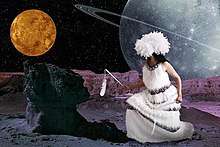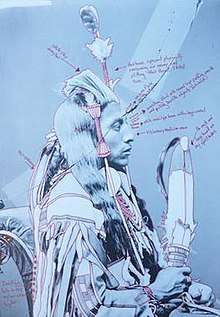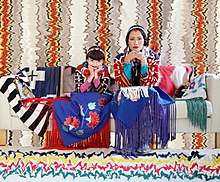Wendy Red Star
Wendy Red Star (born 1981) is a Native American contemporary multimedia artist born in Billings, Montana, in the United States. Her humorous approach and use of Native American images from traditional media draw the viewer into her work, while also confronting romanticized representations. She juxtaposes popular depictions of Native Americans with authentic cultural and gender identities. Her work has been described as "funny, brash, and surreal".[1]
Wendy Red Star | |
|---|---|
_by_Wendy_Red_Star.tif.jpg) Wendy Red Star, "Ashkaamne (matrilineal inheritance)," 2019 | |
| Born | 1981 Billings, Montana United States |
| Education | Montana State University Bozeman, BFA University of California Los Angeles, MFA |
| Known for | Photography, installation, sculpture |
| Awards |
|
| Website | wendyredstar |
Biography and education
Red Star was born in 1981 in Billings, Montana. She is of Apsáalooke (Crow) and Irish descent, and was raised in Pryor, Montana,[2] on the Crow Reservation, "a rural community that's also a sovereign nation and cultural powerhouse."[1] At age 18, she left the reservation to attend Montana State University - Bozeman.[3]
Growing up as bi-racial,[4] Red Star went through identity issues. At elementary school, she was afraid of her classmates knowing that her grandparents were white. When she left the reservation, she had to deal with "otherness": The responses she received to her identity and identity-based artwork often damaged her confidence.[5] She later learned to embrace the identity and was completely comfortable with it at 26 when she had her daughter. She incorporated her cultural identity into her work, reflecting on her childhood and where she grew up.[4]
Her mother was a public health nurse who encouraged Crow cultural pursuits; though Red Star herself did not speak Crow, her adopted Korean sister spoke fluent Crow as a child. Her father ranched and was a licensed pilot who played in the "Maniacs", an Indian rock band. Red Star's uncle Kevin Red Star and grandmother Amy Bright Wings were big influences to her practice.[1][5]
Red Star's undergraduate and graduate level specialization was in sculpture. Her work also includes photography, fashion design, bead work, fiber art, performance art, and painting. In 2004, Red Star was awarded her Bachelor of Fine Art degree from Montana State University, Bozeman.[6] Red Star furthered her studies at the University of California, Los Angeles where she earned a Master of Fine Art degree in 2006.[6]
In 2012–2013, she was a manager at Chief Plenty Coups State Park, located in Pryor, Montana. In 2014, she moved to Portland, Oregon and worked on Medicine Crow and the 1880 Crow Peace Delegation.[5] As of 2016, it was reported that Red Star works as a full-time artist in Portland.[7]
She has lectured both Yale University, Dartmouth College, the California Institute of the Arts and Brown University.[8][9]
Career
Critical reception
The Spokesman-Review noted, "Red Star works in a variety of media. Her fiber work blends traditional and contemporary elements, as in her pieces Rez Car Shawl and Basketball Shawl. Her photographs combine stereotypical and authentic images, references to the past and modern day. Many are self-portraits."[10] Red Star's work often includes cliched representations of Native Americans, colonialism, the environment, and her own family.[11] The Gorman Museum at UC Davis described her work as layering "influences from her tribal background (Crow), daily surroundings, aesthetic experiences, collected ephemera and conjured histories that are both real and imagined."[12] Though she often deals with serious issues of Native American culture, she often employs humor through the inclusion of inflatable animals, fake scenery, and other elements in the work.[13] In her photography, Red Star often depicts herself in traditional elk-tooth dresses that she creates.[14]
Zach Dundas of Portland Monthly noted her "mash-ups of mass-market and Crow culture make perfect sense...Red Star is enjoying a moment in the wider art world. New York's Metropolitan Museum of Art includes her work in a current exhibit of Plains Indian art, and Dartmouth College's Hood Museum is showing her self-portraiture alongside big names like Chuck Close, Cindy Sherman, and Bruce Nauman. Red Star will stage 15 separate exhibitions this year."[1]
According to the description of her APEX exhibit at the Portland Art Museum, her early work "employed gender-focused, political self-imagery...to draw attention to the marginalization of Native Americans."[15] Norman Denizen observed, "Wendy Red Star, Crow Indian cultural activist and performance artist, offers an alternative view, focusing on performances and artworks that contest the images of the vanishing dark-skinned Indian."[16] Her work has been collected at institutions such as the National Museum of the American Indian, the Minneapolis Institute of Arts, and Eiteljorg Museum of American Indians and Western Art.[17]
Advocacy
Red Star has advocated for improved opportunities for Native women in the art world. In 2014, she curated Wendy Red Star's Wild West & Congress of Rough Riders of the World, "the first-ever all-Native contemporary art exhibition at Bumbershoot", which took place in Seattle during the annual musical concert.[18] There were 10 artists that exhibited, and most of them were Native artists that primarily worked with identity-based artworks.[4] In 2017, Red Star curated an exhibition at the Missoula Art Museum called Our Side, which featured four contemporary Indigenous female artists: Elisa Harkins, Tanya Lukin Linklater, Marianne Nicolson, and Tanis S'eiltin.[19]
Works and publications
Thunder Up Above

For "Walks in the Dark" of the Thunder Up Above series, she created a costume with European and Victorian motifs in a Native American design, and photoshopped an interplanetary background. Dundas observes, "The sci-fi results evoke the intrigue and suspicion of first contact with an unknown people—or, as she put it in her artist's statement, 'someone you would not want to mess with'."[1]
Four Seasons
For Red Star's Four Seasons series, the Metropolitan Museum of Art catalog noted, "In this four-part photographic work, Wendy Red Star pokes fun at romantic idealizations of American Indians as 'one with nature.' "[20] Luella Brien of the Native Peoples Magazine wrote the Four Seasons series had an avant-garde quality, with traditional "Native American imagery juxtaposed against authentic imagery".[13] Red Star also uses humor to draw viewers into her work.[13] Blake Gopnik of Artnet News commented, "Posing amid blow-up deer, cut-out coyotes and wallpaper mountains, Red Star uses her series to go after the standard blather about Native American's inevitable 'oneness' with nature."[21] The Saint Louis Art Museum acquired Four Seasons as part of its permanent collection, describing it as among "some of the amazing works of art acquired by the Art Museum in 2014".[22]
White Squaw
Red Star characterizes her work as research-based, especially as she investigates and explores cliched Hollywood images like beautiful maidens or western landscapes.[4] While conducting research on the term squaw, she found a reference to White Squaw, a 1950s movie, and later books with pulp-fiction style covers, published as recently as 1997. Red Star took photographic prints of the covers, substituting her own image in a cheap costume for the character "White Squaw", using all the original taglines, with comical satiric effect.[4]

Medicine Crow & The 1880 Crow Peace Delegation
In 1880, six Crow chiefs traveled to Washington, D.C. to talk with the president because the settlers were about to build a railroad through their hunting territory.[4] She researched Medicine Crow/Peelatchiwaaxpáash (Raven) for her exhibit of the Crow Peace Delegation to Washington in 1880 and discovered the narratives behind elements of the iconic picture. She used a red pen on a print of this famous image to notate his outfit and the symbolism attached to elements such as his ermine shawl, the bows in his hair, and the eagle fan he is holding.[4] Red Star said she wanted to use the details of his clothing, and the ledger drawings he made upon his return to the reservation, to humanize Medicine Crow.[4] What she learns in research emerges in her creative process, which she articulates with visual means.[4]
Circling the Camp
Red Star took photographs at the Crow Fair - a large annual event in Central Montana that happens every third week of August.[23] In an effort to focus on the culture and history of the Crow nation, she removed the background of the pictures to bring attention to the Indigenous people and objects in the foreground.

Apsáalooke Feminist
Most photographs of Crow women are colorless, so Wendy Red Star took photographs herself and her daughter Beatrice with colorful Crow clothes to showcase Crow people's everyday fashion. The patterned background is photoshopped to give the images a visual punch.[24]
Collaborations
In 2013, Red Star began collaborating with her daughter Beatrice Red Star Fletcher, who "figures prominently in her work" and participates as a tour guide for their exhibitions.[25][26] Their collaborations have been shown at the Tacoma Art Museum, the Seattle Art Museum, and twice at the Portland Art Museum.
Collections
Red Star's work is included in:
- the Smithsonian's National Museum of the American Indian,
- the Metropolitan Museum of Art,[27]
- the Figge Art Museum,[28]
- the George Gustav Heye Center,
- the Saint Louis Art Museum,
- the Hood Museum,
- the Crocker Museum of Art,
- the Portland Art Museum,[29]
- the Nelson-Atkins Museum of Art,[30]
- the Nerman Museum of Contemporary Art,[31]
- the Minneapolis Institute of the Arts,
- the Museum of Contemporary Native Arts,
- the C.N. Gorman Museum,
- the Art Museum of West Virginia University,
- the Hallie Ford Museum of Art,
- the Triton Museum of Art,
- the Autry Museum of the American West,
- the Philbrook Museum of Art,[32] and
- the Fralin Museum of Art at the University of Virginia.[33]
Selected exhibitions
Red Star has been actively exhibiting her work since 2003.[34] Her résumé lists the following exhibitions since 2011:[17]
- Parading Culture (Tokens, Gold and Glory) Haw Contemporary Fine Art Gallery, Kansas City, Missouri (2016)
- The Plains Indian: Artists of Earth and Sky: Metropolitan Museum of Art (2015)[35]
- Peelatchiwaaxpáash/Medicine Crow (Raven) & the 1880 Crow Peace Delegation: APEX gallery, Portland Art Museum (2015)[36]
- Tableaux Vivant: Nature's Playground. Seattle Art Fair – Volunteer Park. Seattle, Washington (2015)
- Circling the Camp: Wendy Red Star: Indianapolis Museum of Contemporary Art (2014)[37]
- Crow Women's Objects. Saint Louis Art Museum, St. Louis, Missouri. (2014)
- Wendy Red Star: C.N. Gorman Museum (2014)[38]
- I.M.N.D.N. — Native Art for the 21st Century: The Art Gym, Marylhurst University (2014)[39]
- Contemporary American Indian Art: Nerman Museum of Contemporary Art (2014)[40]
- Making Marks: Prints From Crow's Shadow Press: National Museum of the American Indian (2014)[41]
- Cross Currents: Metropolitan State, University of Denver (2013-2014)[42]
- Biennial Contemporary American Indian Arts Series: Native Voices and Identity Narratives: The A.D. Gallery (2013)[43]
- My Home Is Where My Tipi Sits (Crow Country): Missoula Art Museum (2011)[44]
- American Spirit: Bockley Gallery (2011)[45]
Fellowships and grants
- Joan Mitchell Foundation Emerging Artist Fellowship
- Eiteljorg Contemporary Art Fellowship[46]
- 2017 Louis Comfort Tiffany Foundation[47]
See also
- Native American women in the arts
- Visual arts by indigenous peoples of the Americas
- Indigenous Futurism
References
- Dundas, Zach (2 April 2015). "Wendy Red Star Totally Conquers the Wild Frontier". Portland Monthly. Archived from the original on 17 April 2019. Retrieved 1 March 2016.
- Snow, Jordyn (27 April 2015). "Wendy Red Star". prezi.com. Retrieved March 7, 2016.
Background
- Born in 1981
- Grew up in Pryor Montana on the Crow Indian Reservation
- Niece of Kevin Red Star
- BFA in sculpture from Montana State University
- MFA in sculpture from UCLA
Crow/Apsaalooké Tribe
- Part of the Four Seasons series, completed during Red Star’s undergrad in 2006
- Got the idea from visiting a Museum of Natural History
'The look pulls people in, but as you look closer you can see the image deteriorate, and if you are more privy to Native history you can see it right away'
Wendy Red Star (Crow) Indian Summer
- Incorrectly translated from 'Children of the Large Beaked Bird'
- Nomadic tribe of the Great Plains
- Part of the Missouri Valley Siouan language group
- Currently reside in southeastern Montana
- Reservation was initially 38 million acres, but is now only 2.2 million - Michelman, Jordan (2018-01-30). "Art In The Cafe: A Conversation With May Barruel Of Stumptown Coffee". Sprudge. Archived from the original on 28 August 2017. Retrieved 24 September 2019.
I'm also thinking about Wendy’s statement. How she wrote, 'Since leaving my reservation at age 18 to attend college I have often felt alone'
- "Interview with artist Wendy Red Star. Episode 19". SoundCloud. Retrieved 2016-03-08.
- Mentzer, Morgan (2018). "Wendy Red Star: Owning Your Power". Nea Arts Magazine. Retrieved March 7, 2019.
- "Wendy Red Star" (PDF). Bockley Gallery. Archived from the original on March 6, 2016. Retrieved December 11, 2015.
- "Figge Art Museum - Wendy Red Star". figgeartmuseum.org. Archived from the original on 6 March 2016. Retrieved 2016-03-07.
- "Trusting Your Instincts". Native Arts & Cultures Foundation. April 15, 2015. Retrieved May 5, 2019.
- Hillsbury Auditorium. "Wendy Red Star: "The Insistence of an Apsaalooke Feminist"". Friends of the Institute. Retrieved May 5, 2019.
- Rogers, Adrian. "Artist views Native life with modern lens". Spokesman Review. Retrieved March 1, 2016.
- "Projects/Exhibitions". Wendy Red Star. Archived from the original on September 22, 2015. Retrieved December 11, 2015.
- "Humanities Institute » Artist Lecture by Wendy Red Star". dhi.ucdavis.edu. 16 April 2014. Archived from the original on 17 April 2019. Retrieved March 1, 2016.
- Brien, Luella (December 2014). "Wendy Red Star on the Rise". Native Peoples Magazine. Retrieved December 11, 2015.
- Ostrowitz, Judith (March 9, 2015). "The Plains Indians Exhibition: A Milestone for the Met". The Metropolitan Museum of Art. Retrieved December 11, 2015.
- "APEX: Wendy Red Star - Portland Art Museum". Portland Art Museum. Retrieved March 1, 2016.
- Denzin, Norman K. (September 30, 2015). Indians in Color: Native Art, Identity, and Performance in the New West. Left Coast Press. ISBN 9781629582788.
- "Wendy Red Star Resume" (PDF). Bockley Gallery. Archived from the original (PDF) on March 6, 2016. Retrieved December 11, 2015.
- Graves, Jen (August 20, 2014). "Maybe Don't Wear a Warbonnet to the First-Ever All-Native Art Exhibit at Bumbershoot". The Stranger. Retrieved December 11, 2015.
- "Exhibitions : Our Side: Elisa Harkins, Tanya Lukin Linklater, Marianne Nicolson, and Tanis S'eiltin". Missoula Art Museum. February 24, 2018. Retrieved May 6, 2019.
- "Wendy Red Star - Four Seasons". The Metropolitan Museum of Art, i.e. The Met Museum. Retrieved March 1, 2016.
- "At the Met, Wendy Red Star Pops Indian Cliches – artnet News". artnet News. Retrieved March 1, 2016.
- "New in 2014: Four Seasons by Wendy Red Star |". www.slam.org. Retrieved March 1, 2016.
- Rogers, Adrian (April 19, 2019). "Artist views Native life with modern lens". The Spokesman-review. Retrieved April 19, 2019.
- "DWP Main Stage 2017: Wendy Red Star & Beatrice Red Star Fletcher". Design Week Portland. April 19, 2019. Retrieved April 19, 2019.
- Sarson, Katrina. "Multi Media Artist Wendy Red Star". www.opb.org. Retrieved March 9, 2016.
- "Watch now: Oregon Art Beat, Season 17, Episode 9". PBS Video. February 16, 2016. Retrieved March 8, 2016.
- "Four Seasons Series (Fall), 2006". www.metmuseum.org. Retrieved 2019-09-24.
- "View". Figge Art Museum.
- "1880 Crow Peace Delegation: Peelatchiwaaxpáash/Medicine Crow (Raven), Peelatchixaaliash/Old Crow (Raven), Iichíilachkash/Long Elk, Déaxitchish/Pretty Eagle, Bia Eélisaash/Large Stomach Woman (Pregnant Woman) aka Two Belly, Alaxchiiaahush/Many War Achievements or Plenty Coups, aka Chíilaphuchissaaleesh/Buffalo Bull Facing The Wind". www.portlandartmuseum.us.
- "Nine Crow Clowns". art.nelson-atkins.org.
- Department, JCCC Digital. "Photography Collection". www.jccc.edu.
- "The Last Thanks". philbrook.emuseum.com.
- "Wendy Red Star | Mellon Indigenous Arts Program". indigenousarts.as.virginia.edu. Retrieved 2019-04-23.
- "Wendy Red Star". PDX Contemporary Art. Retrieved March 1, 2016.
- "Art Object". The Metropolitan Museum of Art, i.e. The Met Museum. Retrieved March 1, 2016.
- "Contemporary Native Photographers and the Edward Curtis Legacy - Portland Art Museum". Portland Art Museum. Retrieved March 8, 2016.
- "Circling The Camp: Wendy Red Star – iMOCA". indymoca.org. Retrieved March 1, 2016.
- "C.N. Gorman Museum Events!". gormanmuseum.ucdavis.edu. Retrieved March 1, 2016.
- House, Phinney/Bischoff Design (13 January 2014). "I.M.N.D.N. — Native Art for the 21st Century • Marylhurst University". www.marylhurst.edu. Archived from the original on 11 September 2015. Retrieved March 1, 2016.
- "Contemporary American Indian Art • The Nerman Museum Collection". www.nermanmuseum.org. Retrieved March 1, 2016.
- "Making Marks: Prints from Crow's Shadow". Smithsonian Institution. Retrieved March 3, 2016.
- Hamel, Ken. "CVA: Cross Currents". denverarts.org. Retrieved March 1, 2016.
- "The A.D. Gallery > On View". www2.uncp.edu. Retrieved March 1, 2016.
- Museum, Missoula Art. "Missoula Art Museum - free expression free admission". www.missoulaartmuseum.org. Retrieved March 1, 2016.
- "Bockley Gallery - Exhibitions - Wendy Red Star - American Spirit". bockleygallery.com. Retrieved March 1, 2016.
- "Eiteljorg Fellowship for Native American Fine Art". www.fellowship.eiteljorg.org. Retrieved March 7, 2016.
- Russeth, Andrew (2018-02-15). "Here Are the 2017 Tiffany Foundation Grant Recipients". ARTnews. Retrieved 2018-03-03.